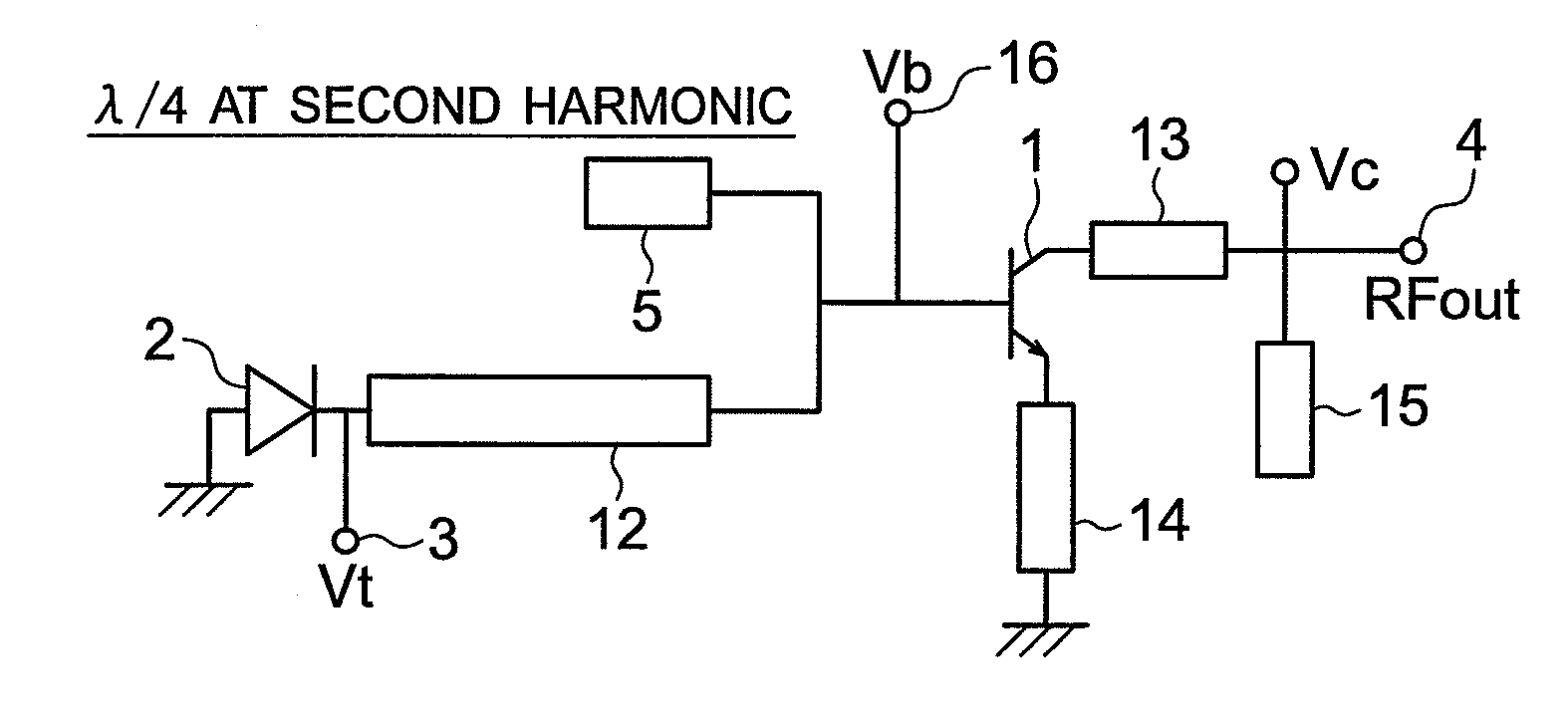Voltage controlled oscillator, mmic, and high frequency wireless device
a voltage control and wireless technology, applied in the direction of oscillator, pulse automatic control, electrical equipment, etc., can solve the problems of low phase noise characteristics, affecting the accuracy of measuring distances or communication errors, and difficulty in making a resonator having a high q value in the vco having an output frequency above 30 ghz, etc., to achieve low phase noise characteristics and low phase noise characteristics
- Summary
- Abstract
- Description
- Claims
- Application Information
AI Technical Summary
Benefits of technology
Problems solved by technology
Method used
Image
Examples
embodiment 1
[0029]FIG. 1 is a structural diagram illustrating a structure of a VCO according to Embodiment 1 of the present invention. FIG. 1 illustrates a VCO having a serial positive feedback structure, which is a harmonic extraction oscillator in which an electric signal having a frequency that is an integral fraction of a desired frequency (i.e., fundamental wave signal) is oscillated so that a harmonic signal is delivered from an output terminal. Reference numeral 1 denotes a transistor; 2, a varactor; 3, a control voltage terminal; 4, a signal output terminal; 5, an open-end stub having a length corresponding to one quarter of the wavelength of the second harmonic signal; 12 and 13, lines; 14, an emitter line; 15, a fundamental wave reflection stub; and 16, a bias voltage terminal. The varactor 2, the line 12, and the control voltage terminal 3 constitute a variable resonator made up of a voltage variable capacitance component of the varactor 2 and an inductance component of the line 12. ...
embodiment 2
[0042]FIG. 2 is a diagram illustrating a structure of a VCO according to Embodiment 2 of the present invention. In FIG. 2, reference numerals 1 to 4 and 12 to 16 denote the same elements as those of FIG. 1, and reference numeral 6 denotes an short-end stub having a length corresponding to the wavelength of a second harmonic signal. The stub that has the short circuit load for the second harmonic frequency and is connected to the variable resonator in parallel can be realized by using the short-end stub, too. It may have the line length defined by Expression (2) below (integral multiple of the wavelength of the second harmonic signal) for the wavelength λ of the second harmonic signal.
nλ(n=1, 2, . . . ) (2)
[0043]The short-end stub 6 having the line length defined by Expression (2) becomes a short circuit load also for the fundamental wave frequency at a low frequency lower than approximately 1 GHz. Therefore, the fundamental wave signal cannot propagate to the variable resonator inc...
embodiment 3
[0053]FIG. 6 is a diagram illustrating a structure of a VCO according to Embodiment 3 of the present invention. In FIG. 6, reference numerals 1 to 4 and 12 to 15 denote the same elements as those of FIG. 1, and reference numeral 7 denotes a bias circuit having a line length from the connection node to the short circuit portion for a high frequency via a capacitor 11 corresponding to the wavelength of the second harmonic signal.
[0054]The same effect as that of Embodiment 2 in which the short-end stub is added can be obtained by letting the bias circuit make a short circuit via the capacitor 11 at the portion separated from the connection node by a distance satisfying Expression (2), without newly adding the short-end stub 6 as described above in Embodiment 2.
[0055]Although the line length of the bias circuit 7 is adapted to be a length corresponding to the wavelength of the second harmonic signal according to the above-mentioned description, this structure is not a limitation. It is ...
PUM
 Login to View More
Login to View More Abstract
Description
Claims
Application Information
 Login to View More
Login to View More - R&D
- Intellectual Property
- Life Sciences
- Materials
- Tech Scout
- Unparalleled Data Quality
- Higher Quality Content
- 60% Fewer Hallucinations
Browse by: Latest US Patents, China's latest patents, Technical Efficacy Thesaurus, Application Domain, Technology Topic, Popular Technical Reports.
© 2025 PatSnap. All rights reserved.Legal|Privacy policy|Modern Slavery Act Transparency Statement|Sitemap|About US| Contact US: help@patsnap.com



